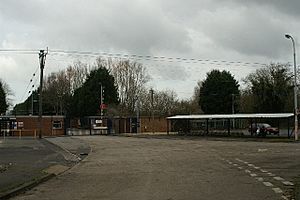ROF Bridgwater facts for kids
The Royal Ordnance Factory (ROF) Bridgwater was a special factory in Somerset, England. It was located between the villages of Puriton and Woolavingington. This factory made powerful high explosives used in munitions, like bombs and shells. It was built a little above sea level. The company BAE Systems closed the factory in July 2008 after all its work was finished.
Contents
History of the Factory
The factory was built at the start of World War II for the British government. It was designed to make a new type of powerful explosive called RDX. Construction began in 1939, and the factory opened in 1941.
On June 29, 1951, an accident happened at the factory, and six men sadly lost their lives. The exact reason for this accident was never found.
The factory was also known as "ROF 37." This name was even used for its sports and social club, called the "37 Club." This club was just outside the factory's main area.
How the Factory Was Built
Making munitions needed a lot of clean water every day, all year round. The factory's location was perfect for this. It could get millions of gallons of water from the wet Somerset Levels.
- The River Huntspill was an artificial river dug when the factory was built.
- The King's Sedgemoor Drain was also made wider at the same time.
- Water also collected in "Borrow Pits." These were areas dug to create protective mounds around the explosive storage buildings.
Today, both the River Huntspill and the King's Sedgemoor Drain are important parts of the water system for the Somerset Levels.
The factory was mostly self-sufficient, meaning it could run itself. It had its own coal-fired power station to make high-pressure steam. This steam was used for heating and for the production process. The factory could also make its own electricity using a steam turbine. During World War II, it was connected to two other power stations for extra electricity.
Between 1940 and 1941, homes were built for the workers in the nearby village of Woolavington. These were "pre-fab" houses, meaning they were built in sections and put together quickly. Hostels, which are like dorms, were built at Dunball for single workers.
The factory was guarded by the Ministry of Defence Police until it became a private company. Their buildings, including barracks and a canteen, were opposite the main gates. These buildings have since been taken down. However, three brick houses that used to belong to the police are still used today.
The factory had its own private railway line connected to the main Great Western Railway. This line had its own train. It was used to bring in supplies like chemicals and coal for the power station. It also helped send out the finished explosives.
In the early 1970s, a bridge was built for the railway line to go over the M5 motorway. This was when the M5 motorway was extended south. The railway line is no longer used, and the tracks have been removed.
What the Factory Produced
During its construction, it was decided that munitions, including the famous bouncing bomb, would be filled with a mix of TNT and RDX. The factory made RDX in two separate units. This RDX was then sent to other factories, called "Filling Factories," to be put into munitions. The factory also cleaned and reused its own sulfuric acid.
Like other Royal Ordnance Factories at the time, Bridgwater was a production factory. This means it focused on making the explosives. The ideas for new explosives and how to mix them were developed at special government research places. After the factory became a private company, some of this research work was taken over by the new company.
After World War II
Between 1945 and the Korean War, when there was less demand for explosives, the factory helped build two-story pre-fabricated concrete houses. These houses were made in sections at the factory.
New Products and Capabilities
The factory added new abilities over the years:
- In 1955, it started making another powerful explosive called HMX.
- In the 1960s and 1970s, the factory began producing plastic rocket propellant. This propellant used ingredients like ammonium perchlorate and a type of rubber.
- The manufacture of Trinitrotoluene (TNT) was added in 1980.
Becoming a Private Company
The Royal Ordnance factories became private companies on January 2, 1985. ROF Bridgwater became part of Royal Ordnance Plc. Later, this company was bought by BAE Systems in the 1990s. The factory finally closed its doors in July 2008.
In 2017, a company called Salamanca Group bought the site. They plan to turn it into "Gravity," a modern, eco-friendly business park. There are talks about building a large factory there to make batteries for electric vehicles. This could be a big step for the future of the site.



